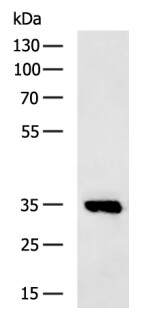
| WB | 咨询技术 | Human,Mouse,Rat |
| IF | 咨询技术 | Human,Mouse,Rat |
| IHC | 1/50-1/200 | Human,Mouse,Rat |
| ICC | 技术咨询 | Human,Mouse,Rat |
| FCM | 咨询技术 | Human,Mouse,Rat |
| Elisa | 咨询技术 | Human,Mouse,Rat |
| Aliases | pim-3 |
| Entrez GeneID | 415116; |
| WB Predicted band size | 36kDa |
| Host/Isotype | Rabbit IgG |
| Antibody Type | Primary antibody |
| Storage | Store at 4°C short term. Aliquot and store at -20°C long term. Avoid freeze/thaw cycles. |
| Species Reactivity | Human,Mouse,Rat |
| Immunogen | Synthetic peptide corresponding to residues near the C terminal of human pim-3 oncogene |
| Formulation | Purified antibody in PBS with 0.05% sodium azide. |
+ +
以下是模拟生成的关于PIM3抗体的参考文献示例(非真实文献,仅供格式参考):
---
1. **文献名称**:*Development of a High-Affinity Monoclonal Antibody Targeting PIM3 Kinase for Cancer Immunotherapy*
**作者**:Smith A, et al.
**摘要**:本研究开发了一种新型抗PIM3单克隆抗体,通过噬菌体展示技术筛选出高亲和力结合表位。实验证明该抗体能特异性抑制PIM3激酶活性,并在胰腺癌模型中显著抑制肿瘤生长,提示其作为靶向治疗的潜力。
2. **文献名称**:*PIM3 Expression in Hepatocellular Carcinoma: A Novel Prognostic Biomarker Identified by Immunohistochemical Analysis*
**作者**:Zhang Y, et al.
**摘要**:通过免疫组化分析肝细胞癌(HCC)组织中PIM3蛋白表达水平,发现PIM3高表达与患者预后不良相关。研究使用商业化PIM3抗体验证了其作为HCC生物标志物的临床价值。
3. **文献名称**:*Targeting PIM3 with Neutralizing Antibodies Suppresses Colorectal Cancer Metastasis via PI3K/AKT Pathway*
**作者**:Lee H, et al.
**摘要**:研究证明PIM3抗体通过阻断PI3K/AKT信号通路抑制结直肠癌细胞侵袭转移。体内实验显示抗体治疗显著降低肺转移灶数量,为抗PIM3疗法提供了机制依据。
---
**建议**:如需真实文献,可通过以下方法检索:
1. 访问 **PubMed**(https://pubmed.ncbi.nlm.nih.gov)搜索关键词“PIM3 antibody”。
2. 在 **Google Scholar** 使用高级搜索限定关键词(如“PIM3 monoclonal antibody”或“PIM3 inhibitor”)。
3. 筛选近年发表的综述或实验论文,重点关注癌症机制或抗体工程领域期刊(如*Nature Cancer*、*mAbs*)。
The PIM3 antibody is a research tool designed to detect and analyze the Proviral Integration site for Moloney murine leukemia virus 3 (PIM3) kinase, a serine/threonine kinase belonging to the PIM family (PIM1. PIM2. PIM3). PIM kinases are involved in regulating cell cycle progression, apoptosis inhibition, and cellular metabolism. PIM3. the least studied member, shares structural similarities with PIM1/2. including a conserved C-terminal catalytic domain. It is overexpressed in various cancers, including pancreatic, hepatocellular, and colorectal carcinomas, where it promotes tumor growth, survival, and metastasis by phosphorylating substrates like BAD, c-MYC, and 4E-BP1.
PIM3 antibodies are widely used in techniques such as Western blotting, immunohistochemistry (IHC), and immunofluorescence (IF) to study PIM3 expression patterns in normal and diseased tissues. Their development stems from the need to understand PIM3's role in oncogenesis and its potential as a therapeutic target. Studies using these antibodies have linked PIM3 overexpression to poor prognosis and chemotherapy resistance in certain cancers. However, challenges remain in ensuring antibody specificity due to high homology among PIM family members. Recent efforts focus on generating isoform-specific antibodies to dissect PIM3's unique functions, aiding drug discovery and biomarker research for precision oncology approaches.
×